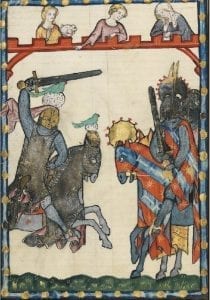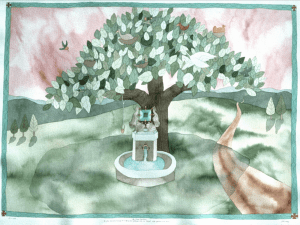

This article is Part 2 in a series about The Grail Romances of the Middle Ages and the Individuation Process by Lans Smith
This marvelous story charts Yvain’s gradual development from an egocentric youth to a mature adult and responsible husband, more responsive to the needs of others than to his own. It takes us from the domestic domain of Arthur’s court into the archetypal realm of the Great Goddess. Yvain leaves the court and rides to a clearing where he sees an enormous tree, with a large emerald supported by four rubies and a spring beneath it, boiling and freezing at the same time. There is a golden cup hanging from the tree that Yvain uses to pour water onto the emerald. When he does so, there is a terrific clap of thunder, followed by a hailstorm.
 All of the elements of this description are archetypal—tree, spring, golden cup, gemstone, and thunderbolt—and together yield one of the great moments in the Arthurian tradition. Celtic mythology revolved around a kind of archetypal arboretum which formed the very basis of their alphabet, poetry, and religious rituals. In Norse myth, the world tree is called Yggdrasil; it is rooted in the underworld and ascends through Middle Earth to branch into the heavens. But the tree is also Biblical, the place where the opposites of good and evil are reconciled: does the spring beneath it boil or freeze? Is the basin iron or gold? Is the slab rock or emerald? All are both and the same, since the tree represents the place where heaven and hell marry on earth, where tempest yields to Paradise, and where iron is transmuted into alchemical gold.
All of the elements of this description are archetypal—tree, spring, golden cup, gemstone, and thunderbolt—and together yield one of the great moments in the Arthurian tradition. Celtic mythology revolved around a kind of archetypal arboretum which formed the very basis of their alphabet, poetry, and religious rituals. In Norse myth, the world tree is called Yggdrasil; it is rooted in the underworld and ascends through Middle Earth to branch into the heavens. But the tree is also Biblical, the place where the opposites of good and evil are reconciled: does the spring beneath it boil or freeze? Is the basin iron or gold? Is the slab rock or emerald? All are both and the same, since the tree represents the place where heaven and hell marry on earth, where tempest yields to Paradise, and where iron is transmuted into alchemical gold.
After the tempest, a Black Knight named Esclados rides out from the castle to confront Yvain. During a long and fierce battle, Yvain severs the Black Knight’s helmet and splits his skull, spattering bloody bits of brain all over his armor. Mortally wounded, the Black Knight races back to his castle with Yvain in fast pursuit. Yvain chases the Black Knight through a portcullis leading into the castle. The gate contains a hidden blade that slices Yvain’s horse in half. The Black Knight, however, escapes through a second gateway into the city, leaving Yvain precariously trapped in a hallway between the two gates.

The crossing this threshold (still a phrase we use for marriage) signifies a transition from the material to the spiritual world. Lunette, a beautiful maid, emerges from a door in the hallway to give Yvain a ring that renders him as invisible. Yvain is now an invisible captive in the realm from which only his wife to be—Laudine, the Lady of the Fountain—can deliver him. Lunette takes Yvain to a secret chamber, where he looks out at the lords and ladies of the castle, who are crazed with grief beside the bier of the Black Knight. The wounds of the corpse suddenly open up again, and the fresh blood runs clear and crimson—positive proof that the man who had killed the Black Knight is nearby.
Yvain is now wounded himself—by the sight of Laudine grieving over the bloody corpse of the Black Knight. “Having mortally wounded her husband,” Yvain wonders, “do I think I can be reconciled with her?” Apparently he can be, for the Queen will need a man to defend her fountain and kingdom, and so she marries Yvain, the man who had killed her husband.
Freudians would no doubt observe the Oedipal complications of the situation, but Jungians would focus on its archetypal symbolism. Laudine—along with her tree, emerald stone, and fountain—symbolizes the Great Goddess, the source of life, into whose mysteries Yvain is initiated. Those mysteries concern a reconciliation of opposites, and a transition from the material to the spiritual world.
Just as the tree embraced the creative and destructive powers nature, so Laudine enacts within her castle walls the mysteries of life and death; the funeral and the marriage ceremonies take place in only a couple of days. These two ceremonies combine the mythical powers of the Great Goddess to take life, and to give it back, through the renewed fertility made possible by marriage.
In your journal write about a magical place in nature, whether actual or in your dreams, which you can revisit in active imagination. You may want to draw or paint that place.

Lans Smith
Evans Lansing ("Lans") Smith, Ph.D., received a B.A. in English from Williams College, an M.A. in Creative Writing from Antioch International (London and Dublin), and a Ph.D. in Literature from The Claremont Graduate School. He traveled with the late Joseph Campbell.
More Posts by Lans Smith1 Comment
Join the discussion and tell us your opinion.
Comments are closed.
Wonderful! I love how the journal instructions make an assumption that everyone (all readers) is already associated with a “magical” place in nature, whether in reality or in dream. I’ve commonly heard of “special” places for people, and have many myself, but “magical” takes the special place to another level which only makes sense, now that I see it mentioned, but I hadn’t thought of it this way before. This is really inspiring. Thank you!